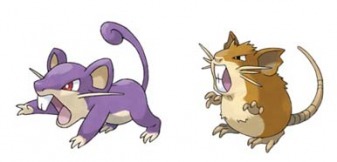o-eheu:Rattata - RaticateGeneric Epithet: Dentisorex (“tooth-rat”)“dēns, dentis ” - tooth + “sōrex,
o-eheu:Rattata - RaticateGeneric Epithet: Dentisorex (“tooth-rat”)“dēns, dentis ” - tooth + “sōrex, sōricis ” - rat– > [ denti- ] + [ sōric- ] – stems– > [ dentisōric- ] – new stem implying “tooth-rat”= “dentisōrex, dentisōricis ” – third-declension masculineSpecific Epithets:Rattata: Dentisorex lascivus (“mischievous tooth-rat”)Raticate: Dentisorex magnidens (“big-toothed tooth-rat”)“magnus -a -um ” - big + “dēns, dentis ” - tooth– > [ magno- ] + [ dent- ] – stems– > [ magno- ] + connecting vowel i + [ dent- ]– > [ magn- ] + connecting vowel i + [ dent- ] – ending o in [ magno- ] disappears before connecting vowel i– > [ magnident- ] – new stem implying “big-tooth”= “magnidens, magnidens, magnidens ” – third-declension adjective meaning big-toothed (cf. bidens, tridens)Bene.Sorex is “shrew mouse” in Latin. That might strike one as more attractive than the Neo-Latin Rattus.Modern Greek uses αρουραίος for “rat,” and that word corresponds to the Classical Greek adjective ἀρουραῖος (aruraeus), “of or from the country.” That modern Greek word seems to be derived from the Classical Greek phrase μῦς ἀρουραῖος (mys aruraeus), which was applied to a field mouse. If we use ἀρουραῖος for “rat,” then the name Dentisorex may have Ὀδονταρούραιος (Odontaruraeus, from ὀδούς, “tooth,” and ἀρουραῖος) as its Greek counterpart.Magnidens can be either μεγαλόδων (megalodon) or μεγαλόδους (megalodus) in Greek. -- source link
Tumblr Blog : o-eheu.tumblr.com
#pokémon#latin#lingua latina#latin language#tagamemnon#rattata#raticate#rats tw#latin translation#latin fandom
